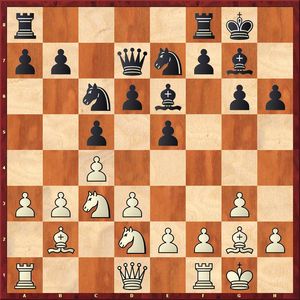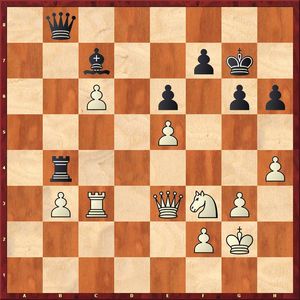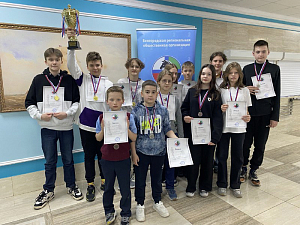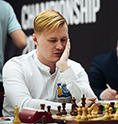Authority of Senior Comrades
Day two of the Tal Memorial reviewed by Vladimir Barsky
– Do not offer me a draw – no way I am going to hear you! - said Vladimir Kramnik to his old friend and rival Boris Gelfand with a smile before the game, and put his earplugs in. Boris followed suit.
It goes without saying that the popular nowadays program “Chess in Museums” has its own specifics. The undoubted advantages are the playhall environment, a picturesque background made up of countless photographs, an increased interest from the public, including people that have nothing to do with chess. On the other hand, those same people create problems for grandmasters - they make noise, to put it simply. Within the period of almost two years of its existence “The Museum of Russian Impressionism” has turned into a point of highest demand on the cultural map of Moscow, the weekend queues here being almost as long as those seen at the French impressionism museum d’Orsay. The museum enjoys a full life: pupils of art schools come here with own easels to create while having the paintings by great masters to look up to, and the kids move around the halls with large pillows in hands for a comfortable seat on the floor opposite the exhibited item of a museum guide’ choice to listen to its story.

The previous edition of Tal Memorial, held in September 2016, had the playing venue accommodated in a small hall on the second floor, with no more than a meter separating the spectating audience from the grandmasters’ tables. This time the playhall is way more suited for needs of a chess event so that spectators are kept at a decent distance and the security constantly reminding them to observe silence. The Kramnik-Gelfand encounter, which we have started this report with, has ended in a draw, which happened not because of diplomatic efforts over the negotiating table, though.
Kramnik – Gelfand
1. Nf3 c5 2. b3 d6 3. c4 g6 4. Bb2 e5 5. g3 Nc6 6. Bg2 Bg7 7. 0-0 Nge7 8. Nc3 0-0 9. d3 h6 10. Nd2 Be6 11. a3 Qd7
This is still theory. White starts by sacrificing a pawn to take initiative on the queenside, while Black gives it back a couple of moves later to get an active piece play.

12. b4 cxb4 13. axb4 Nxb4 14. Ba3 a5 15. Rb1

15…e4 16. Na4
It is obvious that taking the pawn drops a knight after 16. Ncxe4 f5. Now Black has no time to trade on d3 because of Nb6.
16... Ra6 17. Nxe4 b5 18. cxb5 Qxb5 19. Bb2 Ned5 20. Bxg7 Kxg7 21. Rc1 Bd7 22. Nac3 Nxc3 23. Rxc3 Qe5

The black pieces are very active, and there is no getting at their potentially weak pawns a5 and d6 for White.
24. d4 Qe7 25. Qa1 Bf5 26. f3 Qa7 27. e3 Nd5 28. Ra3 Rc8 29. g4 Bxe4 30. fxe4 Nb4

31. d5+?!
White overdoes it. It is true, however, that Kramnik promised to do his best in each game, but not at the cost of such grave positional concessions!
31…Kg8 32. Rc3 Re8 33. Qa4 Qe7 34. Rc7 Qxc7 35. Qxe8+ Kg7 36. e5
“Is Kramnik really up to giving up his bishop on g6?” - an online commentator Sergey Shipov posed a rhetorical question. It was not long before a positive answer to this question arrived.
36…dxe5 37. Be4 Ra7

38. Bxg6
The rapid format is known to give a lot more liberties to grandmasters if compared to the classical chess. In addition, the opponents were blitzing out there moves at this moment already.
38…fxg6 39. Qf8+ Kh7 40. d6 Qg7 41. Qe8 Qd7 42. Qxe5 Qxg4+ 43. Kh1

43…Qc4
Gelfand lacked time to have a calm look at the position to see that White had no real threats and that he could simply push his pawn forward with 43...a4!, because 44. Rf8 fails to 44…Qd1+ 45. Kg2 Qd5+, trading queens.
44. Rf8 Rg7
White has not yet missed his golden opportunity entirely, but after 44... Qd5+ 45. Qxd5 Nxd5 46. e4 he already needs to come up with a couple of tricky to find moves: 46…Kg7! 47.Rc8 Nb6!
45. e4

45…Nd3
The last winning path is so narrow that it clearly defies the rapid format: 45... Nc6 46. Qe8 Rg8 47. Rf7+ Kh8 48. d7 (or 48. Qd7 Qxe4+ 49. Kg1 g5!, taking care of the h7-square) 48... Qc1+ 49. Kg2 Qg5+ 50. Kf1 Nd8! 51. Rf8 Rxf8+ 52. Qxf8+ Kh7 – White is suddently out of checks and his passers have been successfully dealt with.
46. Qe8 Qc1+ 47. Kg2 Qd2+ 48. Kg1 Qe3+ 49. Kf1 Qe1+ 50. Kg2 Qe2+ 51. Kg1 Qd1+ 52. Kg2 Qd2+ 53. Kg1 Qc1+ 54. Kg2 Qd2+ 55. Kg1 Qc1+ 56. Kg2 Qd2+ Draw. This game was the last to finish, and it was watched with great enthusiasm by Arkady Dvorkovich, a mastermind behind the tournaments dedicated to Mikhail Tal’s memory.

In general, round four proved unique: all five games ended in draws, although it was other than for peaceful disposition of opponents. Peter Svidler, for one, literally outplayed Vishy Anand, quite a troublesome rival of his, but then his “happiness” seems to have unsettled him.
Svidler – Anand

After the game, the "senior comrades" (represented by the English-speaking commentators Victor Bologan and Evgeny Miroshnichenko) asked Peter about his reason to refrain from 29.f4. The eight-time Russian champion justified himself by saying that rook endings were not his element, but in general he understood that f2-f4 was a useful move, but kept postponing until a more suitable moment. And a moment came when it was too late already.
29. Rb8+ Ke7 30. Ra8 g5!
Vishy Anand had earned the reputation of a brilliant defender long before Sergey Karjakin took up the post of a defense minister, and a stake of draws from Anish Giri became an invariable attribute of the tournaments scenery.
31. a5 g4 32. a6 Kf6 33. a7 Ra1+ 34. Kg2 Ra2 35. f3 Rxe2+ 36. Kf1 Ra2 37. fxg4 h6 38. h4 Kg7 39. Ke1 e5 40. Kd1 e4 41. Ke1 Draw.
The drawish tendencies continued well into round five. The only winning game was the one in which a senior comrade defeated a younger one.
Gelfand – Dubov

Daniil believed the position to be ripe for opening up, but his judgement proved faulty.
17…c5? 18.Rc3! b6 19. Rc1 h6 20. Qe2 Rb8 21. g3
The situation in the center has stabilized, and White keeps improving his position, gradually expanding on the kingside.
21… Rf8 22. Kg2 Rfd8 23. a3

23…b5?!
This is an emotionally-driven decision: by way of compensation Black gets a couple of active moves. This is not quite enough.
24. Nxc5 b4 25. axb4 axb4 26. Rc4 Nxc5 27. dxc5 Rd5 28. b3 Rbd8 29. Qe4 Kh8 30. h4 g6 31. Qe3 Kg7 32. Rxb4 Qe8 33. c6 Rb8 34. Rxb8 Qxb8 35. Rc4 Rb5 36. Rc3 Rb4

37. Qd3 Rb5 38. Qd7 Kf8 39. Nd4 Rxe5 40. Ra1 Black resigns.
– Beat the dog before the lion! – joked your correspondent, congratulating Gelfand on victory.
– There seem to be not enough "dogs" here! – smiled Boris Abramovich in response.
It so happened that only old-timers were on the winning side on day two. In round six Dubov was upset once again, this time by Kramnik (the crucial position from this game found its way into our column " Position of the Day", while Anand defeated Nakamura.
Anand – Nakamura

Black’s handle of the Giuoco Piano has been underwhelming as he allowed his opponent to seize the initiative.
21. Nd5! Nxd5 22. exd5 c4
The pawn is invincible: 22…Rxd5 23.Be4. However, opening up one bishop Black results in blunting his colleague.
23. Bd2 Bd4 24. Rxa8 Rxa8

25. Bxg6! fxg6 26. Bc3 Rd8 27. Nxe5 Bxe5
The alternative defense is 27... Rxd5 28. Nxg6 Kf7 29. Nf4 Rd7, and a pair of bishops provides for decent chances to bail out. However, he was relying on the notorious opposite-colored bishops ending.
28. Rxe5 Re8 29. f4!
There is no avoiding the trade of rooks, but its attractiveness for Black can be reduced significantly.
29…g5 30. Rxe8+ Bxe8 31. fxg5 hxg5 32. g4 Kf7 33. Kf2 Ba4
This is a correct approach: even if in a roundabout way, the bishop is bound to get into the enemy's rear.
34. Ke3 Bd1 35. Kd4 Bf3 36. Kxc4

36…Ke7?
Hikaru should not have given up his pawns so prematurely. The game was saved by 36... Bg2 37. Kc5 Bxh3 38. d6 Bxg4 39. Kc6 Ke8 40. Kc7 Bd7, etc.
37. Bxg7 Bg2 38. h4!
Now Black is helpless to stop three passers.
38…gxh4 39. Be5 Bf3 40. g5 Kf7 41. b4 Kg6 42. d6 Black resigns.
Thanks to this victory, Vishy Anand caught up with the leader Shakhriyar Mamedyarov and visited the commentator's booth in good spirits to share about his yet another successful performance in Moscow with thousands of English speaking spectators.
Pictures by Vladimir Barsky and Eteri Kublashvili























